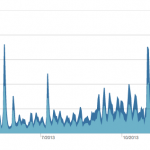Have you seen this graphic?

Media analysts have been buzzing this week about how this chart proves that a December change to the Facebook newsfeed algorithm is bringing the Upworthy media empire crashing down. Upworthy received nearly 50 million viewers in November, while their web traffic in December and January after the change was considerably lower. The timing here makes the cause obvious, right?
Not so fast.
Viral Sites Still Thriving
Business Insider claims that “a quick survey of sites that post similar traffic to Upworthy show that they also saw peaks in November and declines in December, after the Facebook algorithm change.” However, an audit of other viral media websites shows this not to be the case. As Upworthy’s traffic went down, others saw an uptick. Utrend.tv and Distractify both grew from November to December, and ViralNova had no significant change. If the newsfeed algorithm change really was the culprit, you’d expect to see similar drops in viewership across the board.
What Really “Crushed” Upworthy’s Traffic
Upworthy is playing a numbers game. Not everything online can go viral, and that’s even true for a site like Upworthy.

A small number of Upworthy posts make up a majority of their shares and pageviews.
Take a look at Upworthy’s traffic from Quantcast for the entire past year, and you’ll see clearly how a majority of their traffic comes from sporadic “viral” hits.

In November, Upworthy happened to have two particularly viral posts: “9 Out Of 10 Americans Are Completely Wrong About This Mind-Blowing Fact” and “2 People Described The Same Person To A Forensic Artist And This Is What Happened” both drove a huge number of people to their site. This resulted in a much higher monthly viewer count than usual — and you wouldn’t expect to see that many viewers again until the next time Upworthy happens to find back-to-back super-viral hits.
So, the real story here isn’t that December and January had low traffic. It’s that, by chance, November had massive traffic, and that just makes every other month look small in comparison.

Comments